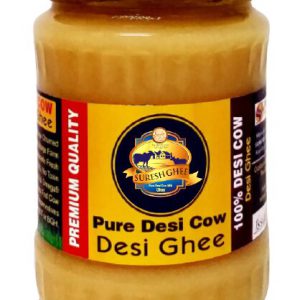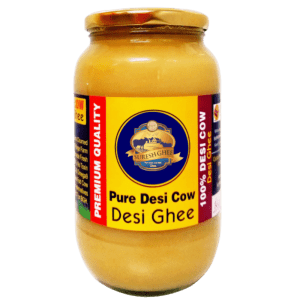Cultured ghee and how is it unique?
As suggested by the name, cultured ghee is prepared from cultured butter. The maker preferred cultured butter. Cultured ghee includes lactic acid in place of lactose present milk. Lactic acid is the premium element of this ghee clarified butter that implies a huge reason for the utilization of cultured ghee.
The amount of lactic acid in cultured ghee is supreme for dairy-sensitive customers. Lactic acid prohibits food tolerance, which is often led by the amount of lactose in this dairy standard.
Cultured ghee is loaded in butyrate and that is why it delivers excellent therapeutic advantages for consumers for issues from constipation or bowel movement syndrome, etc.
Why are people excited about cultured ghee?
Ghee is made by the vedic process by culturing or accumulating cream of milk. In the olden days when there was no system like a refrigerator, people like to add a tablespoon of Dahi or yogurt to skim buttermilk to enhance its shelf life as the cream can’t sustain at room temperature within 1–2 days.
The procedure of preparing cultured ghee is more time-consuming and expensive than clarified butter but the output is way better in taste and aroma than clarified butter or ghee.
Cultured ghee:
This is cultured ghee prepared from raw cow milk. Observe the rich yellow/golden color. The steps of making cultured ghee are as follow:
- Simmer the raw milk for 10–15 min or pasteurized, if the milk is non-homogenized then boil it for 5 min.
- Allow it to cool down at room temperature then put a milk pot into the fridge.
- After 3–4 hours on the surface of the milk, the cream will collect on the top of the milk. Take out that cream into a separate clean container and insert a tablespoon of yogurt / Dahi and mix it well.
- Keep this mixture aside for a few hours based on room temperature.
- The great way is to use culture inside the cream at night and churn the buttermilk by using wooden bilona in the morning while pouring little cold water into a mixture.
- Clean the churned butter 2–3 times with water to avoid the solid cream ingredients.
- Take the buttermilk in a container and boil until the ghee becomes all clear and you can observe the solid brown color buttercream at the bottom.
- With the help of a strainer pour ghee into a clear glass bottle.
Following these steps, you will taste the delicious pure cultured ghee. Buttermilk can be used to prepare different Indian dishes and add a pinch of salt or sugar. This creates the best summer beverage by adding mint and coriander.
Non-cultured ghee:
This is clarified butter or no-cultured ghee prepared from the buttermilk. Still, the color of both cultured ghee and non-cultured ghee prepared from butter is almost similar, cultured ghee has its self-natural delicious taste and aroma which clarified butter doesn’t remain. Still, I will suggest homemade clarified butter/ghee flavors better than store-bought ghee.
Read More : Desi Cow Ghee vs Buffalo Ghee vs Jersey Cow Ghee
Why Cultured Ghee?
- Cultured ghee is a more buttery taste as an output of the fermentation of the cream. Many consumers want the taste and aroma of cultured products.
- Batch-tested for levels of “dairy” (not more than 0.25% lactose sensitivity and not more than 2.5 ppm casein/whey). This evaluation has not been done for our regular Ghee.
- Our traditional cultured ghee preparation has been utilized for thousands of years. The ancient method of Ayurveda suggested cultured ghee is vital for promoting Agni, which regulates the digestive fire.
- Cultured ghee is nothing but our desi cow ghee in India, where the word desi means prepared with the indigenous old method
Cultured ghee vs. ghee: is there any difference?
Although both the things are ghee and clarified butter, there is a line of comparison between these two milk-made varieties.
Non-cultured ghee is flavored with a bland/boring aroma, but cultured ghee is always a high-efficiency refreshing aroma because of the impacts of fermentation. Other than the aroma, both vary in texture too.
One thing that is common for both types of non-cultured and cultured ghee is that they possess longer shelf life, however, cultured ghee has a great shelf life. You can pile the cultured ghee in the kitchen without refrigeration support.
Focussing on the cultured ghee vs. non-cultured ghee, the integral difference in the ingredients. Cultured ghee has zero lactose intolerance, as it is packed with lactic acid only.
If you are sensitive to lactose intolerant, then cultured ghee is a better and secure alternative for you. The lactic acid amount present in cultured ghee is a great helper for food sensitivity issues.
The unique advantages of cultured ghee for the dietary choice
- Promotes gut health: Cultured ghee involves the butyrate, and enhances it as a gut-friendly option for cooking. Infuse ghee into your diet, and you will get rid of a solution to health issues like constipation, irritable bowel syndrome, etc.
- Useful for natural weight loss: Cultured ghee contains health-friendly butyrate and conjugated linoleic acid. Because of its high saturated fat content, ghee in the diet is induced as a filler food. As a cooking oil, it helps to control hunger pang and can limit calorie consumption. If you make a habit of consuming the ghee diet, it can promote natural weight loss. However, you have to ingest ghee in moderation.
- Ghee is good for mental health: Cultured ghee is nutritious for brain health. A suggested amount of ghee in the diet assists in balancing brain health. According to Indian Ayurveda, ghee in the diet is useful in progressing memory power, prohibits the probability of brain disorder diseases, etc. Ghee in the meal can be useful for kids with enhanced focus as well as deliver seniors in memory retention.
- Stimulate the smooth digestion: Cultured ghee is popular for digestion-friendly dairy. If you add it into the diet, it resumes digestion and decreases the issue of high acidity, bloating, etc. The lactic acid in ghee is useful in maintaining the digestive tract functioning, and that is protective for regulating the metabolism of the body.
- Ghee in diet takes care of better eyesight: Ghee promotes good eyesight. It includes vitamin A, and which is a known medicine for eye care by improving eye vision.
- Provide the proper hydration level of the body: Pure cow ghee is a super quality natural nourisher, and it is useful in maintaining the hydration amount of the body. It stimulates the skin softness and regulates the internal tissues of the body soft and flexible.
- Promotes bone health: Pure cow ghee includes a good level of vitamin K that offers the absorption of calcium from meals in the body and enhances in strengthening bones. A moderate amount of ghee in the diet is best for keeping irrepressible bones.
Read More : Desi Cow Ghee For Hair Growth, Hair Fall Treatment & Regrowth Benefits
Ghee is prepared from milk, and cultured ghee is obtained from yogurt or curd. Cultured Ghee is also called desi cow ghee in India, where the word desi implies preparation with the indigenous method.
Conclusion:
FAQ
Cultured ghee delivers a remarkable benefit with its probiotic content. Introducing live cultures that enrich your gut microbiome, supporting digestion, nutrient absorption, and immunity. It improves digestion, nutrient absorption, and strengthens the immune system with its beneficial bacteria. Applying the cultured ghee into your meals delivers an excellent means of implementing probiotics into your diet.
Cultured ghee exhibits remarkable shelf stability, allowing it to be stored at room temperature for an elevated period of time without the risk of spoilage. The removal of milk solids and water consistency during the clarification procedure assures resistance to spoilage and rancidity. Such a characteristic creates it to be a convenient pantry necessary, specifically in Indian households where ghee is a consistent culinary ingredient.
Cultured ghee gives a unique flavor and aroma that can improve your culinary endeavors. The fermentation procedure gains depth and complexity, harnessing a nutty and subtly tangy taste. Either you’re sautéing vegetables, preparing dal, or making some traditional Indian sweets, the richness and aromatic variance of cultured ghee bring a cheerful and distinctive twist to your dishes.
Cultured ghee increases the nutritional advantage of conventional ghee to new heights. Fermentation improves the bioavailability of necessary nutrients, converting it into a potent source of vitamins A, D, E, and K, plus essential fatty acids. Vitamins and fatty acids are important for overall health, boosting immunity, and nourishing your skin.
We prefer pure desi ghee for people of all ages who are very sensitive to dairy products, and our Desi ghee is followed by the Vedic process to make it.
Then pure desi cow ghee presents a lot of differences. If we discuss the cultured ghee vs. ghee and get to know that the cultured ghee is a great choice for lactose-intolerant people.
As it is colon-friendly and improves the digestion tract. But for folks who don’t have any dairy sensitivity, organic grass-fed ghee is an excellent paleo swapper. Buy pure desi cow ghee at our online store by visiting https://sureshfoods.com. .







 WhatsApp us
WhatsApp us
Naveen m...